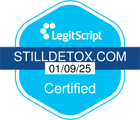What Is A21 Pill?
The A21 pill is a prescription opioid medication formulated to treat moderate to severe pain. It contains 10 mg of oxycodone hydrochloride, an opioid analgesic, and 325 mg of acetaminophen, a non-opioid pain reliever commonly found in Tylenol. Manufactured by KVK-Tech, Inc., this A21 white pill is a Schedule II controlled substance, meaning it carries a high potential for abuse and dependence, according to the Drug Enforcement Administration (DEA).
While chemically identical to Percocet, the A21 10/325 is a generic alternative. Opioid painkillers like A21 white pill one are often misused, leading to rapid dependence. A study published in the Journal of Pain Research found that patients using oxycodone-acetaminophen combinations for more than five days had a significantly increased risk of developing dependence.
Is A21 White Pill a Percocet?
The A21 white pill contains the same active ingredients as Percocet, but while Percocet is a brand-name medication produced by Endo Pharmaceuticals, the A21 pill is a generic formulation.
According to the U.S. Food and Drug Administration (FDA), generic opioids must be bioequivalent to their brand-name counterparts, meaning they have the same dosage strength, absorption rate, and therapeutic effects. However, inactive ingredients may differ, potentially affecting how individuals experience the drug. Some patients report slightly different onset times or durations of pain relief when switching between Percocet and A21 pill white, though medical research confirms both are clinically interchangeable.
How Does A21 Pill Work?
After taking the white pill A21, oxycodone 10 mg begins working within 15 to 30 minutes, binding to mu-opioid receptors in the brain and spinal cord to block pain signals. The acetaminophen component reduces fever and enhances the overall analgesic effect.
Peak effects of A21 white pill occur within 1.5 to 2 hours, and the pain relief lasts between 4 to 8 hours, depending on factors like metabolism, tolerance, and previous opioid exposure.
Studies by the National Institutes of Health (NIH) confirm that combination analgesics like A21 white pill provide superior pain relief compared to taking either oxycodone or acetaminophen alone.
What Is the A21 Used For?
Doctors prescribe the A21 pill white for pain conditions that do not respond adequately to non-opioid medications. Common uses include:
- Post-surgical pain management, where high pain levels require a stronger analgesic.
- Chronic pain conditions, such as severe back pain, arthritis, and nerve-related pain.
- Injury-related pain, including fractures, burns, and soft tissue injuries.
- Cancer pain, where other medications prove insufficient.
However, the CDC’s opioid prescribing guidelines state that opioid medications like A21 white pill should only be used when alternative treatments have failed. Over-reliance on opioids for chronic pain has led to widespread dependence, making careful prescribing essential.
Risks and Side Effects of the A21 Pill
Like all opioids, the A21 white pill Percocet alternative has significant risks, especially when used beyond the prescribed dosage.
Common Side Effects
Patients prescribed the A21 pill may experience:
- Drowsiness and dizziness, which can impair cognitive function.
- Nausea and vomiting, due to the opioid’s effects on the digestive system.
- Constipation, a frequent issue with oxycodone use.
Serious Risks
The most severe A21 white pill risks involve respiratory depression and overdose. The National Institute on Drug Abuse (NIDA) explains that opioids slow breathing, sometimes to fatal levels, especially in high doses or when combined with alcohol or benzodiazepines.
Additionally, acetaminophen toxicity is a serious concern. The FDA warns that exceeding 4,000 mg of acetaminophen per day can cause liver failure, especially when A21 white oval pill is used simultaneously.
Counterfeit A21 White Pill
The A21 pill is frequently counterfeited, with illicit versions often containing fentanyl. A DEA report found that six out of ten counterfeit opioid pills seized in 2023 contained a lethal dose of fentanyl, a synthetic opioid 50 times stronger than heroin.
How Does a Real A21 White Pill Look?
A genuine A21 white pill is an oval, biconvex tablet with a smooth, film-coated exterior, making it easier to swallow. Key identifying features include:
- Imprint: Clearly engraved “A 21” on one side, with no markings on the other.
- Color: Solid white, free from speckles, discoloration, or inconsistencies.
- Shape: Oval (caplet-like) with slightly rounded edges.
- Size: Typically 14-16 mm in length, slightly smaller than some other oxycodone-acetaminophen tablets.
- Texture: Smooth, non-chalky coating, preventing it from easily crumbling.
How to Spot a Fake A21 Pill
- Blurry, smudged, or faded “A 21” imprints instead of a clean, engraved marking.
- Unusual thickness, weight, or an uneven shape.
- A chalky, rough, or easily crumbling texture.
- Off-white or speckled color variations.
White Pill A21 Addiction
Addiction to the A21 white pill can develop within days of continuous use. Studies show that physical dependence can start in just 5 to 7 days, with withdrawal symptoms appearing within 6 to 12 hours after the last dose of A21 white pill (NIDA).
Individuals at the highest risk of developing A21 pill addiction include:
- Those taking high doses for extended periods.
- Individuals with a history of substance abuse.
- Patients using the medication beyond their prescribed duration.
Signs of A21 White Oval Pill Dependence
Dependence on the A21 white pill can develop quickly, with common warning signs including:
- Needing higher doses to achieve the same relief.
- Cravings and compulsive use despite negative consequences.
- Experiencing withdrawal symptoms between doses.
How to Safely Stop Taking A21 Pill
Abruptly stopping the A21 white pill can cause severe withdrawal symptoms, including sweating, tremors, nausea, muscle pain, and anxiety. To prevent this, doctors recommend a gradual tapering process.
A Structured Opioid Withdrawal Program Typically Includes:
- Slow dose reduction to minimize withdrawal symptoms.
- Medication-assisted treatment (MAT) such as buprenorphine or methadone to reduce cravings (SAMHSA).
- Behavioral therapy to address psychological dependence.
A study in the Journal of Addiction Medicine found that patients using MAT and supervised tapering had significantly higher success rates in avoiding relapse compared to those who quit abruptly.









